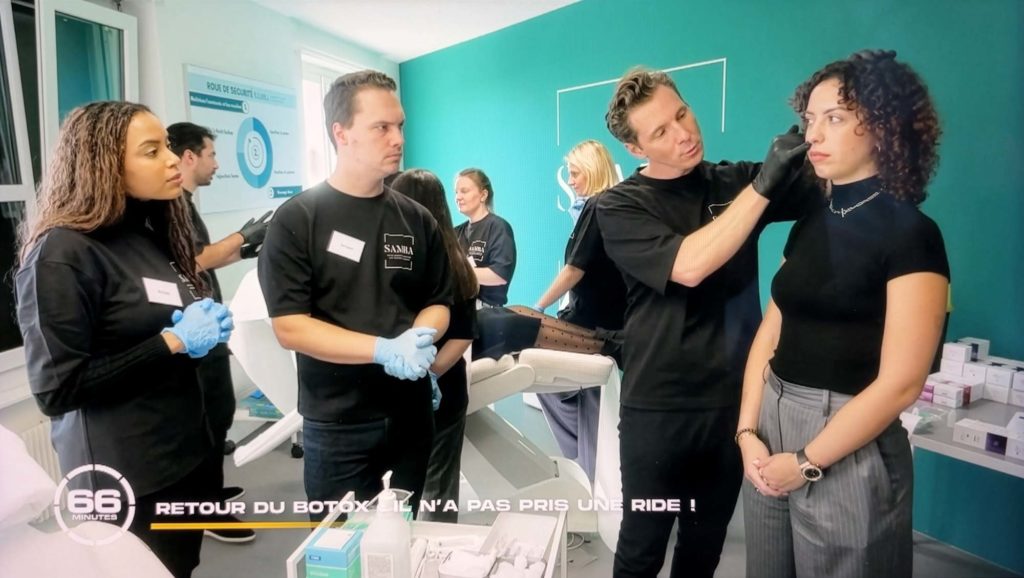Today, I’m going to address some of the most common questions, fears and misconceptions about aesthetic medicine. I’ll try to shed some objective light on them, so that you can approach aesthetic medicine in the best possible way.
“She was so beautiful before, do you know how she is now?”
The facts
A classic theme in discussions with our patients. We take the example of a well-known personality who, overnight or gradually, has literally become deformed. Lips, cheeks and nose have been excessively transformed or irreversibly damaged.
So how can these celebrities, who can afford the services of the greatest specialists, undergo such transformations as to make them unrecognizable and, above all, much less attractive to the general public?
The malfunctioning process
In fact, it’s a dysfunction in the doctor-patient relationship. In fact, these personalities are often much more vulnerable than we think. Most of the people who gravitate towards these personalities derive secondary benefit from them. Their relationships are skewed, and advice is not always benevolent.
Some unscrupulous doctors set aside basic ethics and professionalism to give in to the siren calls of money. Patients, for their part, lose their critical faculties and their sense of reason, demanding more and more, often driven by the stress of no longer being “bankable”.
What I often say to my patients is that it’s indeed striking, visible and shocking, but that it’s in no way representative of the benefits that can be derived from well-executed, quality medicine or cosmetic surgery with the right indication.
I’d like to add that in recent years, we’ve seen the return of celebrities who may have appeared “fake”, and who in a few weeks or months regain a harmonious face.
In most cases, this is due to excess hyaluronic acid injected in the wrong place (subcutaneously) and which, fortunately, can be dissolved by hyaluronidase.
How to avoid it
Demand doctors trained in modern, evidence-based aesthetic medicine techniques.
“I don’t want to be frozen, I want to keep my expression.
The facts
This phrase is often used in consultations, and it’s true that it can happen. It’s important to distinguish between two types of excess in aesthetic medicine that can lead to the appearance of a frozen face.
The first type of frozen face: botulinum toxin in the wrong dosage
Botulinum toxin is a protein that is injected into the skin muscles of the face, mainly in the upper third. There are many brands on the market (Botox®, Vistabel®, Dysport®, Azzalure®, Xeomin®, Bocouture®, Jeuveau®, Nuceiva®, Daxxify®, Letybo®, Alluzience®, Relfydess®). But choosing a brand has nothing to do with being static.
Botulinum protein replaces the neurotransmitter acetylcholine, temporarily preventing muscle contraction. The peaucier muscle is connected to the bone and skin, and its contraction causes the skin to break, ultimately resulting in a wrinkle. If this contraction is constrained or limited, the wrinkle does not form, and skin tensioning leaves an attenuated wrinkle.
The malfunctioning process
If too much botulinum toxin is used, particularly on the forehead, the upper third of the face will freeze, which is not very desirable.
Fortunately, a well-trained practitioner will know perfectly how to dose your botulinum toxin treatment, which is proving to be an extremely effective product, both preventive and curative, for aging of the upper third of the face.
In short, botulinum toxin is a bit like salt in a recipe: when there’s too much, it’s indigestible; when there’s none at all, it’s a bit bland…
How to avoid it
Demand doctors trained in modern, evidence-based aesthetic medicine techniques.
Second type of frozen face: excess hyaluronic acid
Patients often tell me “I don’t want botulinum toxin, because I’m afraid I’ll look too stiff” or “it makes the face puff up”. After telling them about the consequences of the wrong dosage, I explain that, very often, the cause of a frozen or expressionless face is poorly positioned hyaluronic acid injections.
The malfunctioning process :
To maintain expression and give the face a tensor and lift effect, hyaluronic acid must be positioned deep against the bone. In the vast majority of cases, due to lack of training, knowledge and experience, the practitioner will inject it under the skin, in the subcutaneous plane.
And I’m not talking about beauticians who have no idea of the anatomy and existence of different hyaluronic acid injection planes. But that’s another debate, it’s called the illegal practice of medicine, involving injury to the physical integrity of others, and is punishable by imprisonment.
If hyaluronic acid is injected in excess just below the subcutaneous level, it will crush the fat and decorrelate the cutaneous level from the muscular and fatty level, resulting in an expressionless face, as if a gelatinous mask had been placed on the surface of the facial fat and muscles.
How to avoid it
As you can see, both hyaluronic acid and botulinum toxin are incredible products, with exceptional efficacy and rare safety. But they must be injected in the right place, with the right product and in the right quantities. What’s more, they must be combined with other lifting treatments (HIFU ultherapy®, radiofrequency Thermage®) if they are to have a natural and above all lasting effect, respecting the harmony and difference of everyone’s face.
For that, demand doctors trained in modern, evidence-based aesthetic medicine techniques.
“The more I inject, the more it will migrate, the heavier my face will become”.
The facts
Yes, hyaluronic acid gel can migrate over time if not injected in the right place.
More and more patients, through the videos they watch on social networks, are asking me about the risk of hyaluronic acid migration. Botulinum toxin is a protein invisible to the naked eye, with a negligible molecular weight, which cannot migrate and accumulate.
The malfunctioning process
The phenomenon concerns hyaluronic acid gel or any other gel injected under the skin, in the subcutaneous or fatty plane.
How to avoid it
In the cheekbone area, the hyaluronic acid gel is injected deep into the bone, where it is held by both the SMAS (Superficial Musculoaponeurotic System) and the ligaments, notably the zygomatic-cutaneous ligament and the ORL (Orbicularis Retaining Ligament). As a result, the product cannot migrate, gives a natural lifting effect, and maintains facial expression for a long-lasting effect.
“Does hyaluronic acid stay under the skin forever?”
The facts
Yes, cross-linked hyaluronic acids can leave a residue. They lose their rheological capacity, but do not degrade to 100%. This was highlighted in an article by English journalist Alice Hart Davis.
It remains like a film under the skin. In my opinion, this is not a problem as long as the filler is injected in the right place.
How to get around this problem
As I explained earlier, properly injected and in the right layer, the filler doesn’t migrate.
I would add that if there are long-term residues, and if these are on the periosteum, they will perpetuate the result.
With age, the periosteum, and the facial mass as a whole, regresses in size. This can sometimes be as much as a centimetre on the chin. This means that even if there is a residue of hyaluronic acid in this area, it will counteract the phenomenon of bone resorption over the long term.
“If I start and then stop, will it be worse than before?”
The facts
No, I don’t. I often answer this question during consultations. In my opinion, cosmetic medicine is a win-win situation if it’s done right.
The process working
About botulinum toxin
Once-in-a-lifetime botulinum toxin injections for frown lines. Over a period of 4 to 6 months, the muscles of the glabella (processus and corrugator muscles), crow’s feet (obicularis oris) and forehead (frontalis) will relax, improving and regenerating the dermis and thus the wrinkle.
If you never use them again, you’ve had 6 months of wrinkle prevention. There’s no negative rebound.
In the long term, botulinum toxin could weaken the expression muscles, but I’d say that’s exactly what we’re looking for: a soft expression that doesn’t break the dermis and creates few wrinkles, while maintaining a natural expression.
About hyaluronic acid
It’s a question of injecting the right quantities, the right product and, above all, in the right place, so that it fits in perfectly with the phenomenon of facial aging over the long term. Then, if you stop, the product gradually resorbs and you return to your natural ageing curve without any negative rebound. You’ve been slowing down the aging process all this time.
What I advise you to do
Combination treatments
With your hyaluronic acid and botulinum toxin injections, combine with these other procedures such as fibroblast biostimulation (HIFU ultherapy®, Thermage® Morpheus® radiofrequency), mesotherapy, vascular lasers, resurfacing lasers (Fraxcel®), pigment lasers and IPL, profhilo®, PRP (platelet-rich plasma), calcium hydroxyapatite (CaHA radiesse®, Harmonyca®), PLLA (L-poly-Lactic acid, Sculptra® Lanluma®).
All these treatments are designed to correct skin imperfections that appear over time, or stimulate skin tone and quality.
The principle is simple: as long as you’re doing it, you’re being preventive or even curative. When you stop, you’ll gradually return to a classic aging curve with no negative rebound.
Once again, everything you’ve done is gain. When you stop, you don’t lose that gain, you’ve just slowed it down.
Of course, for that, demand doctors trained in modern, evidence-based aesthetic medicine techniques.





